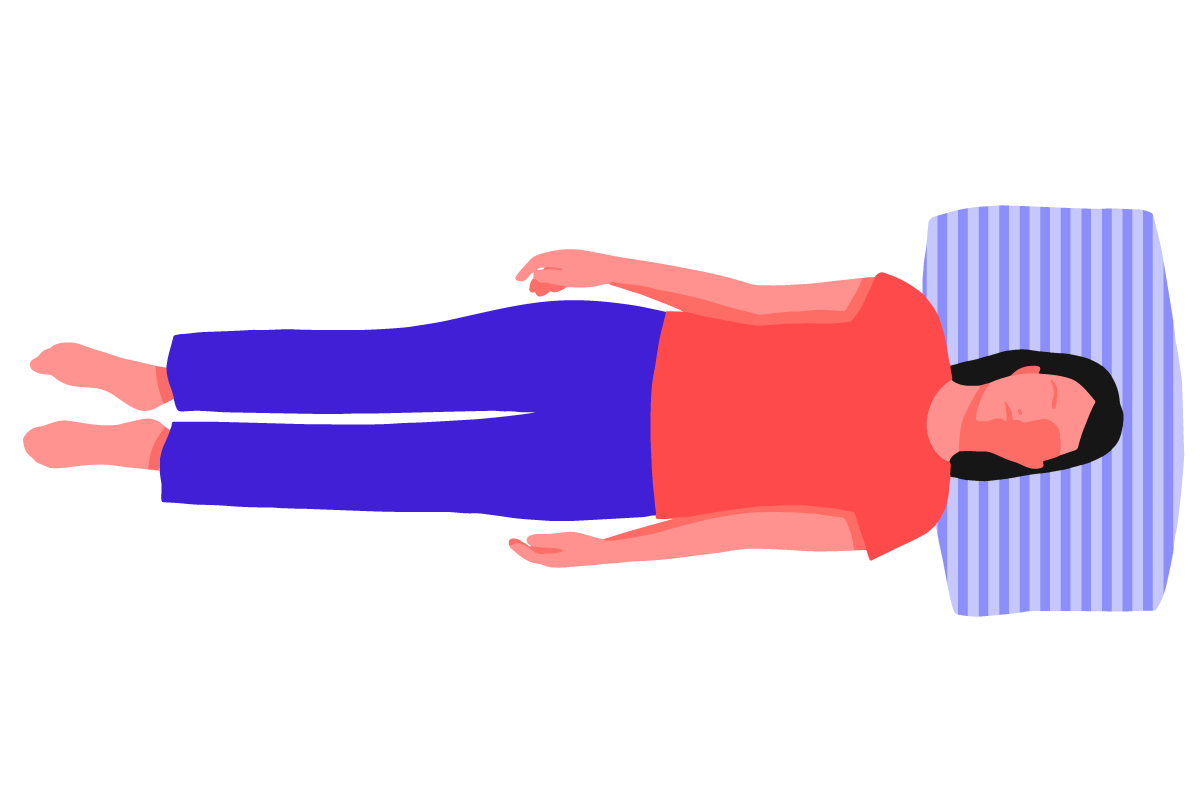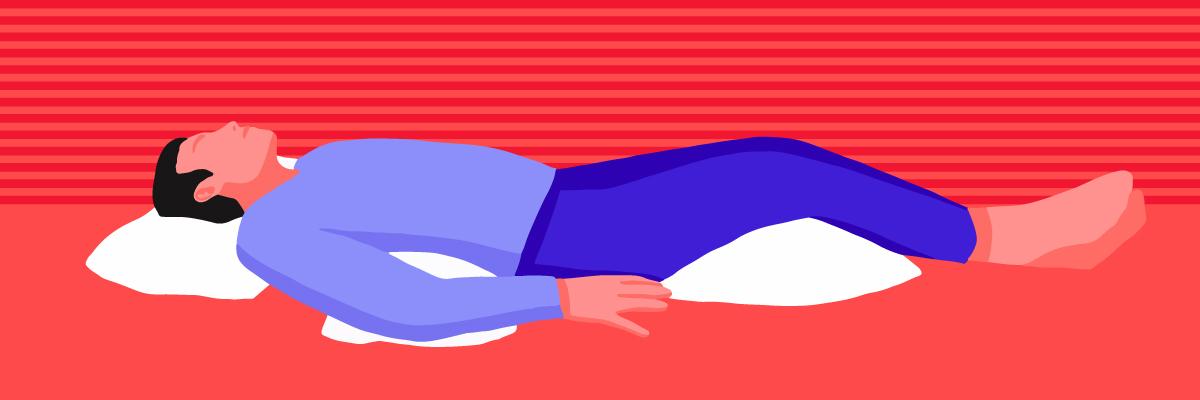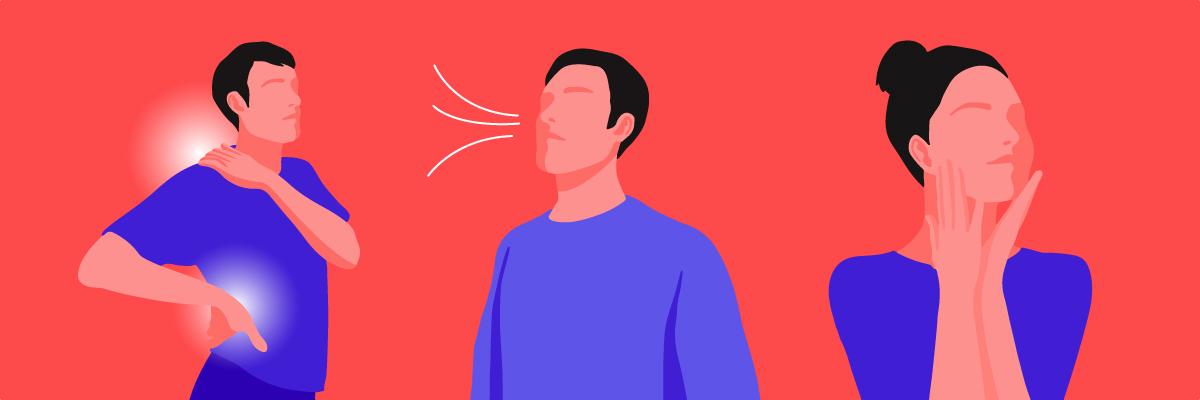The Supine Sleep Position: Discover the Benefits and Risks

Discover the benefits and risks of the supine sleep position. Read our complete guide to learn the correct way to sleep on your back and more.
The supine sleep position, also known as back sleeping, is the second most common position (next to side sleeping). While it comes with benefits, there are also risks.
In a nutshell, sleeping in a supine position may worsen symptoms of obstructive sleep apnea and GERD. And it’s also best to avoid this sleep position during pregnancy.
This article lists the benefits of the supine sleep position and explains each in detail. It also discusses when you shouldn’t sleep this way and why. And, describes the correct way of sleeping in this position to reap the benefits.
Here’s what this blog post covers:
What is the Supine Sleep Position?
The supine sleep position involves lying flat on your back with your arms at your sides and legs slightly apart. It is considered one of the best sleeping positions. When done properly this position keeps your spine, neck, and head aligned while sleeping. And in many instances, keeps airways open during sleep.
The Supine Sleep Position: How to Do It Right

This may come as a surprise but when it comes to the supine sleep position, your mattress and pillows matter.
Choose a firm mattress. A too-soft one won’t give your back the support it needs in this position. A mattress that sags in the center, especially, is a no-no.
Now on to the pillows. Your head and neck must get adequate support so they stay aligned with your back. Some people make the mistake of piling on the pillows or using one high pillow. Others choose a pillow with a too-low loft.
Neither of these will keep your neck and head aligned with the natural curvature of your spine. What you need is a pillow with a medium loft (about 3 to 5 inches). You can also choose one shaped like a wedge or a memory foam pillow.
If you’re not careful, the supine sleep position can also put pressure on your back. Again pillows come in handy. For extra support, place one under your lower back where your spine curves. A thin one under your knees helps keep your back’s natural curvature in the right position.
Using pillows in these ways can also make transitioning to the supine sleep position from another easier. Additionally, you can add more pillows around your hip area if you move a lot while sleeping. This can help you maintain the supine sleep position.
💡 Key Takeaway: It’s important to know the right way of sleeping in a supine position so you can enjoy its benefits. Investing in a firm mattress and the right pillows keep your spine aligned with your neck and shoulders. They also provide additional back support.
Benefits of the Supine Sleep Position

We already know that the supine sleep position promotes optimal spine alignment. But other benefits make this way to sleep one of the best ones yet.
May Reduce Neck, Back and Head Pain
Provided it's done right, the supine sleep position may lessen neck and back pain. According to Healthline, it’s a position that rests your back and can be likened to standing up straight(1).
Imagine standing hunched over with your head turned to one side for a long time. This spells soreness and aches for most. Like standing straight, sleeping on your back doesn’t put unnecessary pressure on your joints.
When it comes to head pain, the supine sleep position supposedly eases tension headaches. And that’s because there’s minimal pressure on your noggin. Cleveland Clinic says that sleeping on your back is one of the best ways to manage the pain(2).
Facilitates Better Breathing in Some Cases
As we mentioned earlier, sleeping on your back opens your airways in some cases. The supine sleep position takes the pressure off your diaphragm. This allows for deeper breathing. Whereas, sleeping on your side or tummy may compress it, causing your breathing to be shallow. This makes the supine position one of the best sleeping positions for breathing problems.
A study in the National Library of Medicine shows that slower, deeper breaths promote melatonin production(3). This sleep hormone helps you relax and promotes sleepiness.
The supine sleep position is also ideal for sinusitis. Sleeping on your back with your head above your heart eases congestion. So, make sure to put a pillow under your head and let gravity clear your nasal passages.
However, sleeping on your back can increase the likelihood of snoring. More on this later, so keep reading.
It’s the Better Sleep Position for Your Skin
The supine sleep position has several benefits for the skin on your face.
First, sleeping on your back keeps your face away from your pillow. And we hate to break it to you but your pillowcase is a catch-all for sebum from your skin and hair. This can irritate your delicate skin and cause blackheads and whiteheads to appear.
Another benefit is that you’re less prone to sleep creases and wrinkles. Sleeping with your face (or part of it) on your pillow will pull and stretch your skin. It’s inevitable.
It might also help reduce puffiness. Sleeping on your side or belly can lead to a buildup of fluid — where gravity takes it. Lying on your back with your head supported by a pillow help you look less puffy when you wake up.
💡 Key Takeaway: When done right, the supine sleep position has many pros. It may prevent or ease neck and back pain, as well as tension headaches. It keeps your airways open and makes deep breathing possible. It’s also the best position for protecting the skin on your face.
Another variation of the supine position is the zero gravity sleep position, which involves lying on your back with your legs slightly elevated, using an adjustable bed.
When Not to Sleep in a Supine Position
Every sleep position has its downside and this one is no exception. There are a few risks associated with specific health conditions. Read on to discover what they are.
When You Have Obstructive Sleep Apnea (OSA)
First, a brief description of this sleep-related breathing disorder. OSA is when you stop and start breathing as you sleep.
It occurs repeatedly and results in loud snoring and waking up gasping for breath or choking. It also results in drowsiness during the day.
Sleeping in the supine position causes the back of your tongue and soft palate to fall to the back of your throat. This is already characteristic of OSA, so sleeping on your back only worsens it.
This disorder may also be a result of sleeping in a supine position. Science Direct says that over half of OSA patients can be categorized as supine-related OSA(4).
If You Suffer From Gastroesophageal Reflux Disease (GERD)
GERD happens when the acid from your stomach backwashes into your esophagus repeatedly.
It causes heartburn, and stomach and chest pain. Plus, it can make swallowing difficult. Sometimes you may feel like there’s a lump in your throat when you don’t. It can also induce coughing, laryngitis and asthma.
Sleeping in a supine position aggravates the symptoms. It allows for an easier flow of stomach acid to your esophagus. And can lengthen the time it stays there. Not a good thing.
While You’re Pregnant
It’s not advisable to sleep on your back while pregnant, especially during the second and third trimesters. (Near impossible too, if you think about it.) It's simply not one of the best sleeping positions for pregnancy.
The reason behind this is the supine position puts the full weight of your uterus and baby on your back. This also puts pressure on your insides, including the vena cava.
This is a major vein that carries blood from the heart to the rest of your body. What this means is decreased circulation and oxygen supply for both you and your baby.
Side sleeping is a better option.
💡 Key Takeaway: Sleeping in the supine position isn’t advisable for those with obstructive sleep apnea as it may worsen the symptoms. Those with GERD should steer clear of it as it lets stomach acid backwash easily. It’s also not recommended for pregnant women as it decreases their blood circulation and oxygen supply.
FAQs on the Supine Sleep Position
To summarize what you’ve learned so far from this article, we answer common questions on the supine sleep position and then some.
Is it good to sleep in a supine position?
Also known as sleeping on your back, the supine position is generally considered to benefit sleep quality. It helps prevent or ease neck and back pain, as well as tension headaches.
Additionally, it may improve breathing before and during sleep because it doesn’t put pressure on your diaphragm. This allows for slower, deeper breathing, which triggers the release of the sleep hormone, melatonin.
The supine sleep position is also kind to the skin on your face. It helps prevent puffiness and skin irritation. This sleep posture doesn’t lead to sleep creases and wrinkles, too.
What are the risks associated with the supine sleep position?
Sleeping in a supine position should be avoided in the following circumstances:
-
When you suffer from obstructive sleep apnea (OSA)
-
When you have GERD
-
During pregnancy, especially the third and second trimesters
The supine sleep position causes your palate to collapse to the back of your throat aggravating sleep apnea.
For those with GERD, this position allows for stomach acid to flow back and forth from your gut to the esophagus.
Avoid sleeping in the supine position while pregnant. It puts pressure on your organs and lessens the flow of blood and oxygen to you and your baby.
What’s the healthiest position to sleep in?
The healthiest sleep position is on your back with a pillow supporting the natural curve of your neck. This helps keep your spine aligned, reducing strain on your muscles and joints.
Side sleeping positions are also beneficial for those who suffer from acid reflux or GERD. It’s also good for obstructive sleep apnea so long as you keep your back straight.
Side sleeping is also recommended for pregnancy. Put a pillow between your legs and one behind your back for support.
What’s the unhealthiest sleeping position?
Supposedly, the unhealthiest sleeping position is sleeping on your belly. It strains your neck and back muscles, leading to pain and discomfort.
It also restricts breathing and increases the risk of snoring and sleep apnea due to airway obstruction.
Conclusion
The supine sleep position has many benefits. But it also comes with its own set of risks. Understand what they are so you know when you should switch to another. If you have underlying health conditions and are considering switching to this position, consult your doctor, first.
Knowing the correct way of sleeping in this position keeps you comfortable while letting you enjoy the perks. Make sure to invest in the right pillows and mattresses. Don’t forget to keep your environment dark and quiet with a sleep mask and earplugs, too.
Keep in mind that good sleep gives you the fuel you need to power through your day. Sleep position matters when it comes to the quality of your zzzs. And it also says a lot about your personality. Read our article to discover what your sleep position says about you.
Sources:
(1) “8 Reasons Sleeping on Your Back May Solve Your Sleep Issues.” Healthline, www.healthline.com/health/sleep/sleeping-on-your-back-may-help-you-get-the-rest-you-need#pain. Accessed 23 February 2023.
(2) “Easing Your Tension Headaches: 7 Tips From a Chiropractor.” Cleveland Clinic, health.clevelandclinic.org/7-tips-for-easing-your-tension-headaches/. Accessed 23 February 2023.
(3) “Self-Regulation of Breathing as an Adjunctive Treatment of Insomnia.” National Library of Medicine, www.ncbi.nlm.nih.gov/pmc/articles/PMC6361823/. Accessed 23 February 2023.
(4) “Supine position related obstructive sleep apnea in adults: Pathogenesis and treatment.” Science Direct, www.sciencedirect.com/science/article/abs/pii/S1087079213000099. Accessed 17 February 2023.
Disclaimer: The information contained in this website or provided through our blog, e-mails, or programs is for informational purposes only. It is not intended to be a substitute for medical advice, diagnosis or treatment that can be provided by your healthcare professionals.












































